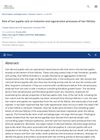TLDR Ageratum conyzoides extract promotes hair growth and regrowth.
The study explores the hair growth-promoting effects of standardized Ageratum conyzoides extract (ACE) on human follicle dermal papilla cells and C57BL/6 mice. ACE was found to inhibit 5α-reductase activity, modulate estrogen receptor signaling, and activate Wnt/β-catenin and MAPK pathways, enhancing hair growth pathways and antioxidant defenses. In mice, oral administration of ACE significantly enhanced hair regrowth, with the 50 mg/kg dose showing effects comparable to minoxidil. Histological analysis showed increased hair follicle number and size. Despite promising results, further clinical studies are needed to confirm ACE's efficacy and safety in humans.
 January 2022 in “Journal of St. Marianna University”
January 2022 in “Journal of St. Marianna University” Substances from human hair cells can affect hair loss-related genes, potentially leading to new treatments for baldness.
 15 citations
,
April 2014 in “Experimental Dermatology”
15 citations
,
April 2014 in “Experimental Dermatology” Scientists developed a system to study human hair growth using skin cells, which could help understand hair development and improve skin substitutes for medical use.
 321 citations
,
December 2009 in “Journal of Dermatological Science”
321 citations
,
December 2009 in “Journal of Dermatological Science” Dermal cells are key in controlling hair growth and could potentially be used in hair loss treatments, but more research is needed to improve hair regeneration methods.
32 citations
,
August 2006 in “Archives of Dermatological Research” Dermal papilla cells can help regrow hair follicles.
January 2003 in “Chinese Journal of Reparative and Reconstructive Surgery” Dermal papilla cells can help form hair follicles and produce hair.
 66 citations
,
August 2001 in “Experimental Dermatology”
66 citations
,
August 2001 in “Experimental Dermatology” Human hair follicle cells can grow hair when put into mouse skin if they stay in contact with mouse cells.
 57 citations
,
November 1998 in “Wound Repair and Regeneration”
57 citations
,
November 1998 in “Wound Repair and Regeneration” Hair papilla cells can create and regenerate hair bulbs under the right conditions.





